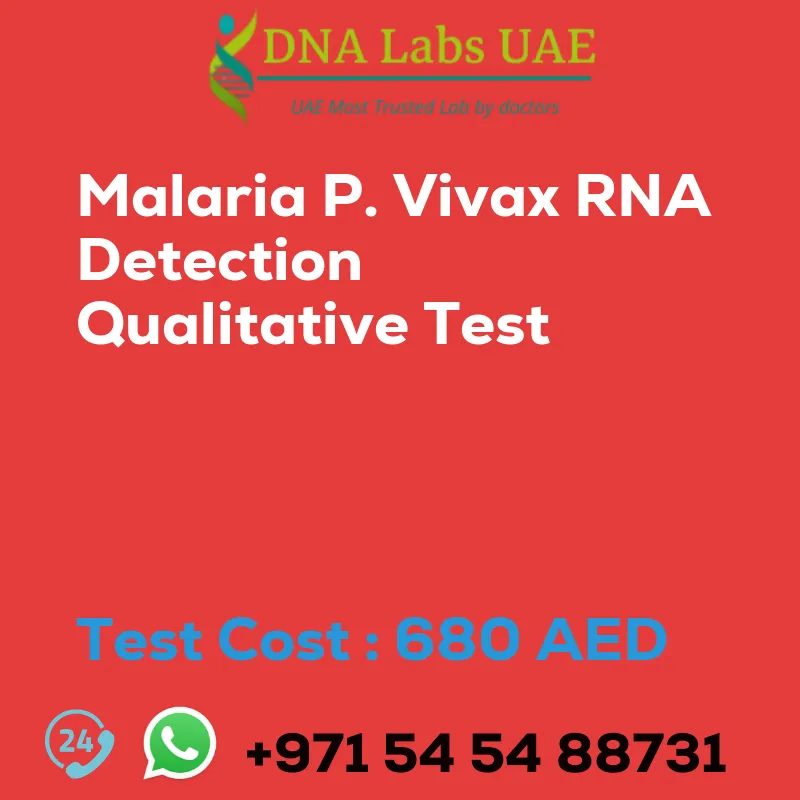Malaria P. Vivax RNA Detection Qualitative Test
Cost: AED 680.0
At DNA Labs UAE, we offer the Malaria P. Vivax RNA Detection Qualitative Test at a cost of AED 680.0. This test is designed to detect the presence or absence of RNA from the Plasmodium vivax parasite, which is responsible for causing malaria.
Test Components
- Price: AED 680.0
Sample Condition
The test requires a whole blood sample in dried spot condition.
Report Delivery
Test results will be delivered via email within 36 hours on the 3rd working day. Results can also be obtained over the phone within 24 hours.
Method
The Malaria P. Vivax RNA Detection Qualitative Test is performed using a method called Real Time PCR.
Test Type
This test falls under the category of Viral tests.
Doctor
The test is conducted by a qualified Physician.
Test Department
The Malaria P. Vivax RNA Detection Qualitative Test is conducted in our Genetics department.
Pre Test Information
Prior to the test, patients are required to sign a consent document and provide any relevant clinical history related to Malaria (P. Vivax) (RNA Detection) Qualitative Test.
Test Details
The Malaria P. Vivax RNA Detection Qualitative Test is a qualitative test that detects specific RNA sequences of the Plasmodium vivax parasite in a patient’s blood sample. The test follows a step-by-step process:
- Sample collection: A blood sample is collected from the patient suspected of having malaria using a finger prick or by drawing blood from a vein.
- RNA extraction: The RNA is extracted from the blood sample using specialized laboratory techniques, separating it from other blood components.
- Reverse transcription: The extracted RNA is converted into complementary DNA (cDNA) using reverse transcriptase enzyme.
- PCR amplification: The cDNA is amplified using specific primers designed to target the RNA sequences of Plasmodium vivax.
- Detection: The amplified DNA is detected using methods like gel electrophoresis or fluorescent probes, confirming the presence of specific RNA sequences of Plasmodium vivax.
- Interpretation: Test results are interpreted as positive or negative for the presence of Plasmodium vivax RNA. A positive result indicates an active infection, while a negative result suggests the absence of the parasite’s RNA.
Please note that this qualitative test only detects the presence or absence of Plasmodium vivax RNA in the blood sample. It does not provide information about the parasite’s load or the severity of the infection. Additional tests, such as quantitative PCR or microscopy, may be required for further analysis.
| Test Name | Malaria P. Vivax RNA Detection Qualitative Test |
|---|---|
| Components | |
| Price | 680.0 AED |
| Sample Condition | Whole Blood,dried spot. |
| Report Delivery | 3rd Working Day Email:-36 hours. On phone: 24hrs |
| Method | Real Time PCR |
| Test type | Viral |
| Doctor | Physician |
| Test Department: | Genetics |
| Pre Test Information | Need to sign Consent document and bring any clinical history of patient forMalaria (P. Vivax) (RNA Detection) QualitativeTest |
| Test Details |
The qualitative test for detecting RNA of Plasmodium vivax, the parasite that causes malaria, involves the detection of specific RNA sequences in a patient’s blood sample. This test is typically performed using a method called reverse transcription-polymerase chain reaction (RT-PCR). Here is a step-by-step overview of the test: 1. Sample collection: A blood sample is collected from the patient suspected of having malaria. This can be done using a finger prick or by drawing blood from a vein. 2. RNA extraction: The RNA is extracted from the blood sample using specialized laboratory techniques. This step involves breaking open the red blood cells and separating the RNA from other components of the blood. 3. Reverse transcription: The extracted RNA is converted into complementary DNA (cDNA) using an enzyme called reverse transcriptase. This step is necessary because the PCR amplification process requires DNA as a template. 4. PCR amplification: The cDNA is then amplified using specific primers that target the RNA sequences of Plasmodium vivax. These primers are designed to bind to the specific regions of the parasite’s RNA, allowing for the amplification of these target sequences. 5. Detection: The amplified DNA is then detected using various methods, such as gel electrophoresis or fluorescent probes. This step confirms the presence of the specific RNA sequences of Plasmodium vivax in the patient’s blood sample. 6. Interpretation: The test results are interpreted as either positive or negative for the presence of Plasmodium vivax RNA. A positive result indicates an active infection with the parasite, while a negative result suggests the absence of the parasite’s RNA. It is important to note that this qualitative test only detects the presence or absence of Plasmodium vivax RNA in the blood sample. It does not provide information about the parasite’s load or the severity of the infection. Additional tests, such as quantitative PCR or microscopy, may be required to determine these factors. |








